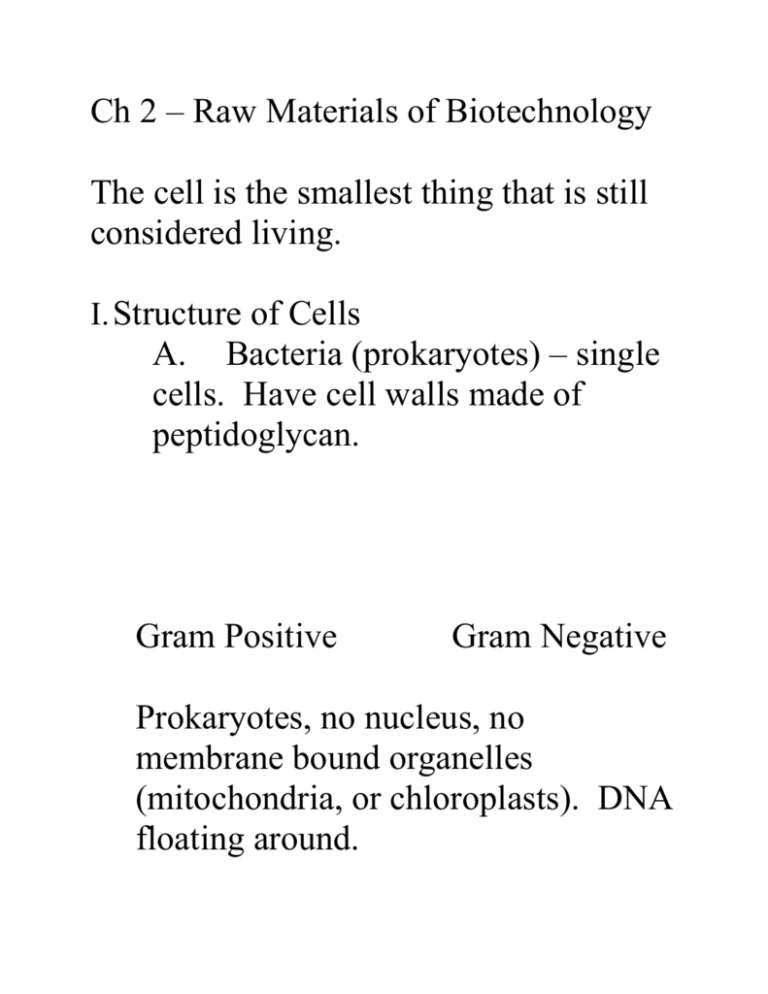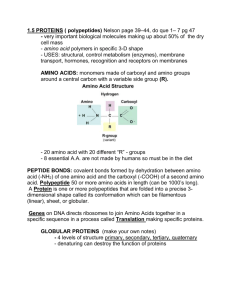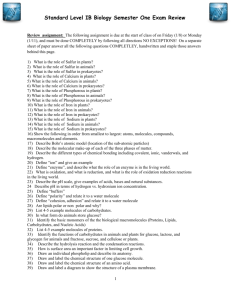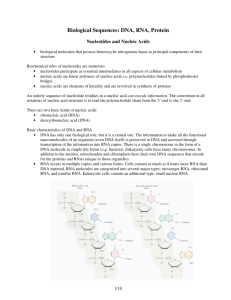Ch 2 – Raw Materials of Biotechnology
advertisement

Ch 2 – Raw Materials of Biotechnology The cell is the smallest thing that is still considered living. I. Structure of Cells A. Bacteria (prokaryotes) – single cells. Have cell walls made of peptidoglycan. Gram Positive Gram Negative Prokaryotes, no nucleus, no membrane bound organelles (mitochondria, or chloroplasts). DNA floating around. B. Plants have cell walls and chloroplasts. Tend to look boxy. Do photosynthesis. Eukaryotic C. Animals no cell walls and have lysosomes. Some show movement (muscles). D. All cells have: 1. Plasma Membrane – barrier. Selectively permeable (some things can go through, others are kept out). 2. Cytoplasm/Cytosol – the space/liquid that fills the cell. 3. Ribosomes – make proteins. 4. DNA/RNA – stores information for making proteins. II. Cells of particular interest for biotechnology A. Prokaryotes: Escherichia coli (E. coli), easy to grow, reproduces quickly, easy to manipulate. B. Eukaryotic Cells – more similar to us… 1. CHO – Chinese Hamster Ovaries 2. Vero – African Green Monkey (kidneys) 3. Hela – Human cervical cancer cells (Henerietta Lacks) III. 4 Main types of macromolecules: Carbohydrates, Lipids, Proteins, Nucleic Acids. Carbohydrates: Made of Carbon, Hydrogen, Oxygen. 1. Monosaccharide: glucose (one piece – monomer) 2. Disaccharide: sucrose (2 pieces – dimer) 3. Polysaccharide: starch (more than 2 pieces – polymer). Long chains, with lots of bonds, lots of energy. Good source of energy for plants and animals. Some are strong A. and used for structures like wood, shells of insects. 4. We breakdown carbohydrates with enzymes like amylase and transform into ATP using cellular respiration. B. Lipids: Fats, Oils, Cholesterol, some hormones 1. Ex: LDL – bad cholesterol, phospholipids (cell membranes), testosterone… Most lipids are hydrophobic (don’t mix with water). 3. Phospholipids are both hydrophobic and hydrophilic. 4. Sterols can be good or bad for our health. Some cholesterol clog arteries (LDL) others unclog (HDL). Other sterols help send messages in our bodies (hormones). C. Proteins: used for: structure (muscle), enzymes 2. (chemical reactions), transport (hemoglobin), storage (albumin – eggs), lots of other functions. Antibodies are proteins that fight infection/disease. 1. If DNA is the blueprint… proteins are the workers, the materials and the buildings. 2. Most biotech companies are working on how to make the right proteins to… treat a disease, etc… The structure of proteins: a) Made of amino acids. There are 20 different amino acids… like an alphabet… if you combine them in different patterns or order you get different “words.” b) These combine to make thousands and thousands of different proteins. 3. Each amino acid has a chemical formula, which causes it to bond or stick together differently with each other amino acid. The way the amino acids stick together gives proteins a 3D shape c) 4. A protein’s shape is key to its function. If you change its shape it will not work right. a.When you change the shape of a protein, it’s called denaturing. There are several things that can cause denaturing: Heat/cold pH can change the shape Chemical changes like: salt, or a solvent. 2.3 continued… still… D. Nucleic Acids: Contain genetic information (instructions for making an organism). 1. DNA – DeoxyriboNucleic Acid. In the nucleus. ~3 billion base pairs. 2. RNA (mRNA, tRNA, rRNA…) mRNA Copies the genes in DNA and takes the message to the ribosomes in order to make proteins. tRNA takes the amino acids to the ribosomes. rRNA makes up the ribosomes. The structure of DNA: is a double helix. Made out of nucleotides. Nucleotides have 3 parts: phosphate, 5 carbon sugar (pentose), nitrogenous base. There are 4 bases (Adenine,Thymine,Guanine, Cytosine). Always pair up A-T and G-C. Form the “rungs” of the “ladder.” Phosphate and sugars form the “sides” of the “ladder”. Phosphate sugar bonds are stronger than the hydrogen bonds between the bases. The two sides of the ladder are called complimentary strands. ATTCGCA TAAGCGT RNA similar to DNA in that it has: nucleotides, it uses bases. Different: uses ribose instead of deoxyribose. It uses Uracil instead of Thymine. A-U, G-C. RNA is usually single stranded.










